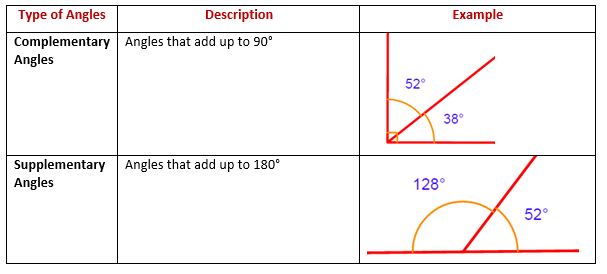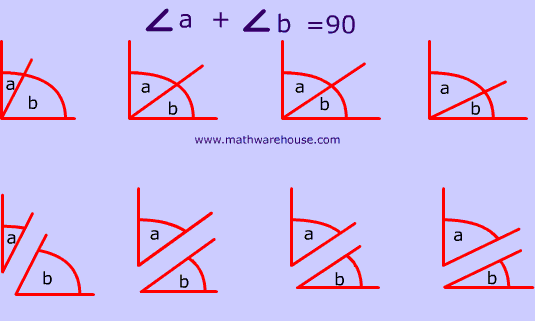When talking about complimentary angles always remember that the angles appear in pairs. How to find complementary angles.
 Complementary Angles And Supplementary Angles Video Lessons Examples And Solutions
Complementary Angles And Supplementary Angles Video Lessons Examples And Solutions
If the sum of two angles are 180 o then the angles are said to be supplementary angles.

What are complementary angles. If any two angles sum to exactly 90 90 then they are two complementary angles. If any angle of y is less than 90 o then. In other words when complementary angles are put together they form a right angle 90 degrees.
Although a right angle is 90 degrees but it cant be called a complementary because it doesnt appear in pairs. Complementary angle of y 90 o y o. Complementary angles 2 Two complementary angles are x4 and 2x - 7 find the value of x.
Trigonometric Ratios of Complementary Angles In Mathematics the complementary angles are the set of two angles such that their sum is equal to 90. For example 2 puzzle pieces that form one 90 o angle when they are put together. One angle is complementary to the other or One angle is the complement of the other.
Notice that together they make a right angle. What Are Complementary Angles. Two angles are complementary if the sum of the angles is equal to 90º ninety degrees.
What Are Complementary Angles Two angles are called complementary angles if the sum of their degree measurements equals 90 degrees right angle. 60 and 30 are complementary angles. Runways are named by a number between 01 and 36 which is generally one tenth of the azimuth of the runways heading in degrees.
A runway numbered 09 points east 90 runway 18 is south 180. Complementary angles are pair angles with the sum of 90 degrees. For example 30 and 60 are complementary to each other as their sum is equal to 90.
Because 30 60 90 Clearly 30 is the complement of 60 and 60 is the complement of 30. 5 and 85 are complementary angles. The name of the game is identifying complementary angles.
For example an angle that is 30º and an angle that is 60º are two complementary angles. Since 90º is the measurement for a right angle another way to tell if two angles are complementary is if together they form a right angle. Complementary angles definition is - two angles that add up to 90 degrees.
Complementary angles are two angles that add up to exactly 90 90. Whereas if the sum of two angles is 90 degrees then they are said to be complementary angles and they form a right angle together. The two angles can be part of the same or different figures.
Two Angles are Complementary when they add up to 90 degrees a Right Angle. The two angles do not need to be together or adjacent. Each one of these angles is called the supplementary of the other.
RWY Calculate the opposite direction of the runway 13. Complementary angles are 2 angles whose measures add up to 90 o. 30 and 60 are complementary angles.
Complementary angle definition either of two angles that added together produce an angle of 90. In this 6th grade exercise identify the correct complementary pair by inference match the complementary angles and answer our in-out boxes. These two angles 40 and 50 are Complementary Angles because they add up to 90.
One of the complementary angles is said to be the complement of the other. Supplementary angles and complementary angles are defined with respect to the addition of two angles. Two angles are Complementary when they add up to 90 degrees a Right Angle.
Two angles are said to be complementary angles if they add up to 90 degrees. One angle is the complement of the other angle. They dont have to be next to each other just so long as the total is 90 degrees.
If the sum of two angles is 180 degrees then they are said to be supplementary angles which forms a linear angle together. Finding Complementary Angles - Type 2. Complementary angles are always in a pair.
If sum of two angles is 90 they are complementaryFor example30 60 90Since sum of both angles is 90So they are complementaryAre these angles complementary35 65 100 90Since sum of both angles is not 90So they arenot complementaryAre these angles complementary45 45 90Sinc. Complementary angles do not need to be adjacent angles or oriented in the same direction. Here POR is said to be complementary angle of ROQ and ROQ is said to be complementary angle of POR.
If the sum of two angles is 90 ⁰ then those two angles are called as complementary angles.